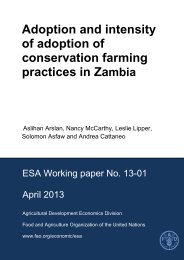Adoption and intensity of adoption of conservation farming practices in Zambia
Adoption and intensity of adoption of conservation farming practices in Zambia
Adoption and intensity of adoption of conservation farming practices in Zambia
You also want an ePaper? Increase the reach of your titles
YUMPU automatically turns print PDFs into web optimized ePapers that Google loves.
<strong>Adoption</strong> <strong>and</strong> <strong><strong>in</strong>tensity</strong> <strong>of</strong> <strong>adoption</strong> <strong>of</strong> <strong>conservation</strong> <strong>farm<strong>in</strong>g</strong><br />
<strong>practices</strong> <strong>in</strong> <strong>Zambia</strong><br />
Aslihan Arslan, Nancy McCarthy, Leslie Lipper,<br />
Solomon Asfaw <strong>and</strong> Andrea Cattaneo 1<br />
This paper analyses the determ<strong>in</strong>ants <strong>of</strong> farmer <strong>adoption</strong> <strong>of</strong> <strong>conservation</strong> <strong>farm<strong>in</strong>g</strong> <strong>practices</strong><br />
us<strong>in</strong>g panel data from two rounds <strong>of</strong> the Rural Incomes <strong>and</strong> Livelihoods Surveys that were<br />
implemented <strong>in</strong> 2004 <strong>and</strong> 2008. Conservation <strong>farm<strong>in</strong>g</strong> (CF) has been actively promoted <strong>in</strong><br />
seven <strong>of</strong> <strong>Zambia</strong>’s n<strong>in</strong>e prov<strong>in</strong>ces s<strong>in</strong>ce the 1980s. CF has the technical potential to<br />
contribute to food security <strong>and</strong> adaptation to climate change; however, rigorous analyses <strong>of</strong><br />
the determ<strong>in</strong>ants <strong>of</strong> <strong>adoption</strong>/dis-<strong>adoption</strong> <strong>of</strong> these <strong>practices</strong>, are still scarce. This paper fills<br />
this gap by comb<strong>in</strong><strong>in</strong>g rich panel data with historical ra<strong>in</strong>fall data to underst<strong>and</strong> the<br />
determ<strong>in</strong>ants <strong>of</strong> <strong>adoption</strong> <strong>and</strong> <strong><strong>in</strong>tensity</strong> <strong>of</strong> two CF <strong>practices</strong>: m<strong>in</strong>imum/zero tillage <strong>and</strong><br />
plant<strong>in</strong>g bas<strong>in</strong>s. Controll<strong>in</strong>g for the confound<strong>in</strong>g effects <strong>of</strong> household level unobservables, we<br />
f<strong>in</strong>d that extension services <strong>and</strong> ra<strong>in</strong>fall variability are the strongest determ<strong>in</strong>ants <strong>of</strong> <strong>adoption</strong>,<br />
suggest<strong>in</strong>g that farmers use these <strong>practices</strong> as an adaptation strategy to mitigate the negative<br />
effects <strong>of</strong> variable ra<strong>in</strong>fall. Eastern prov<strong>in</strong>ce shows a significantly different trend <strong>in</strong> terms <strong>of</strong><br />
both <strong>adoption</strong> <strong>and</strong> the <strong><strong>in</strong>tensity</strong> <strong>of</strong> <strong>adoption</strong>, <strong>in</strong>dicat<strong>in</strong>g that the long-established CF activities<br />
<strong>in</strong> the prov<strong>in</strong>ce have had some impact – though high dis-<strong>adoption</strong> rates are observed even <strong>in</strong><br />
this prov<strong>in</strong>ce.<br />
Key words: <strong>conservation</strong> agriculture, <strong>conservation</strong> <strong>farm<strong>in</strong>g</strong>, m<strong>in</strong>imum tillage, technology<br />
<strong>adoption</strong>, adaptation, <strong>Zambia</strong><br />
JEL Codes: Q12, Q16, Q54, O33<br />
1<br />
Arslan is a natural resource economist at the Agricultural Development Economics Division<br />
<strong>of</strong> the Food <strong>and</strong> Agriculture Organization <strong>of</strong> the United Nations; McCarthy is a pr<strong>in</strong>cipal<br />
research analyst <strong>of</strong> LEAD Analytics Inc., Wash<strong>in</strong>gton D.C.; Lipper is a senior environmental<br />
economist, Solomon Asfaw is an economist, <strong>and</strong> Andrea Cattaneo is a senior economist all<br />
are at the Agricultural Development Economics Division <strong>of</strong> the Food <strong>and</strong> Agriculture<br />
Organization <strong>of</strong> the United Nations.<br />
iii



